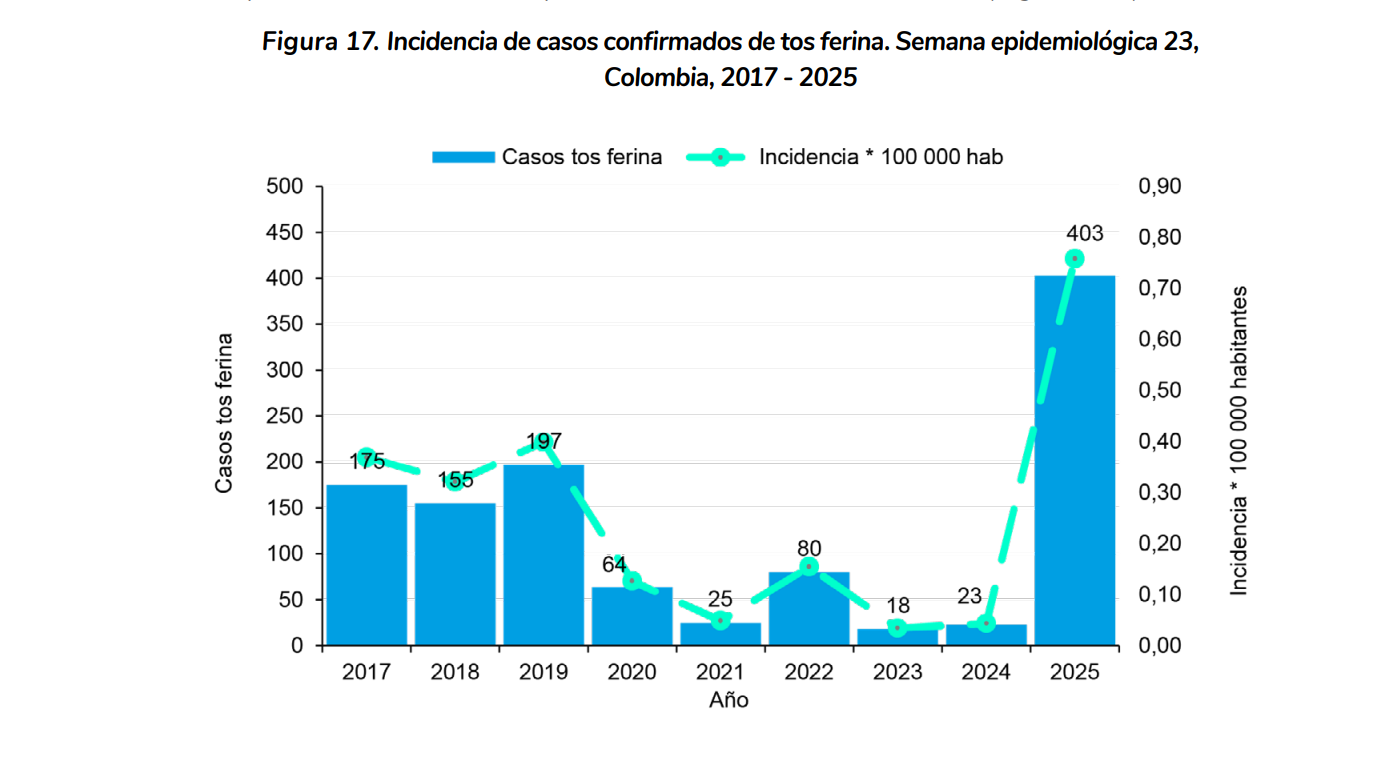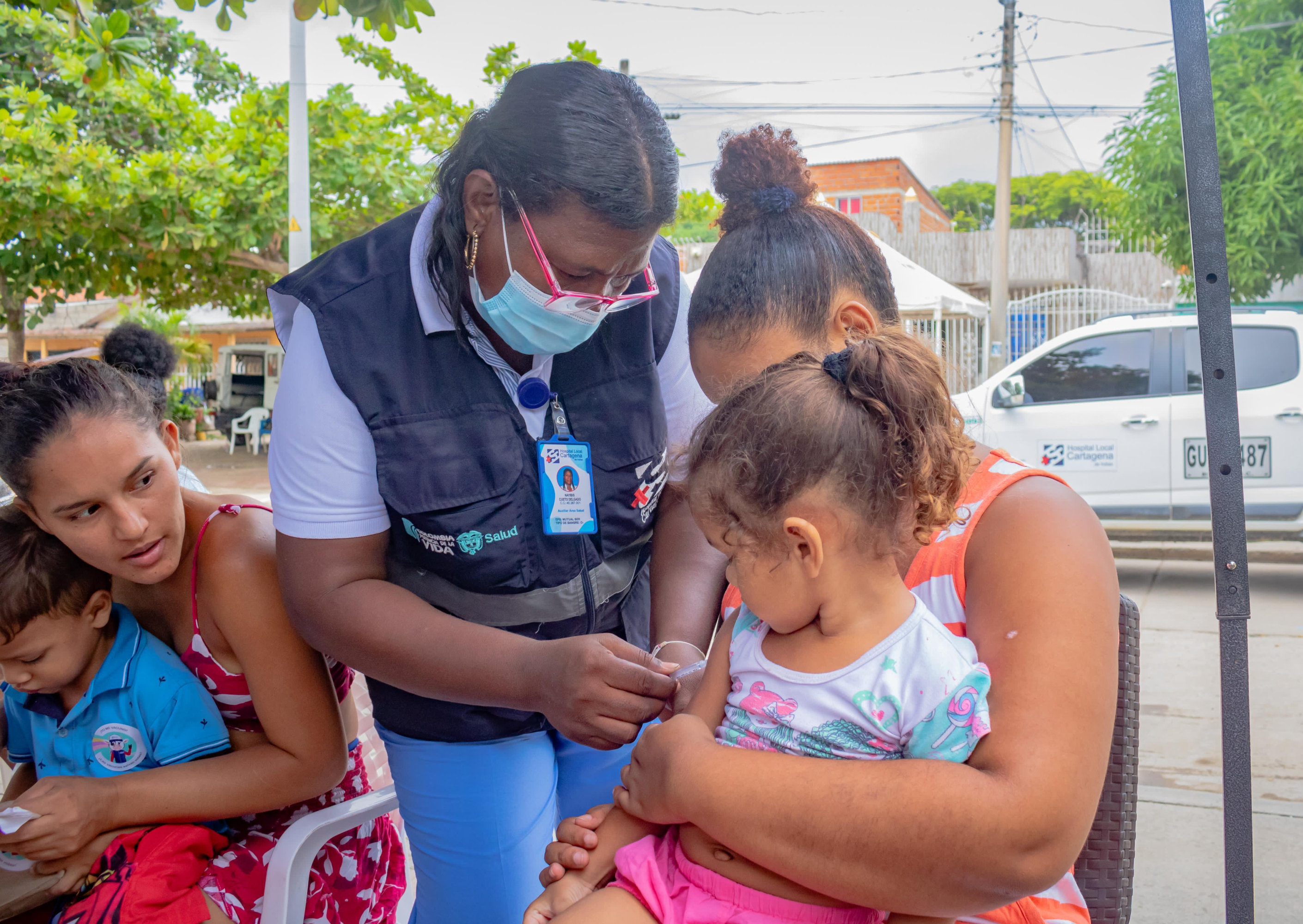Whooping cough cases are skyrocketing in the country: the disease poses a risk especially to children.

Colombia is currently experiencing an outbreak of whooping cough, an infection known as the "100-day cough," which poses a risk, especially to young children who are not vaccinated. According to data from the National Institute of Health's Weekly Epidemiological Bulletin, as of June 14, 2025, a total of 2,882 possible cases of whooping cough have been reported nationwide. Of these, 14%, equivalent to 404 cases (403 from Colombia and one case from abroad), have been confirmed; 68.1% (1,963 cases) have been ruled out, and 17.9% (515 cases) are under investigation.
While the figure seems low, the truth is that the incidence is skyrocketing. In 2025, the national incidence reached 0.76 cases per 100,000 inhabitants. When compared with historical records for the same epidemiological week, an increase is observed compared to the years 2017 to 2024, when the incidence did not exceed 0.40 cases per 100,000 inhabitants. At the same time last year, only 23 cases were recorded; in 2023, there were only 18; and in 2022, there were 80 as of June 14 of that year.

Incidence of confirmed cases of whooping cough. Photo: INS
"For epidemiological week 24 (until June 14) of 2025, the whooping cough event was found to be higher than expected, while the other events analyzed through this methodology were within the historical reporting pattern," the INS states. The highest number of cases is reported in Bogotá, with 164 cases and an incidence of 2.07 cases per 100,000 inhabitants, followed by Antioquia with 90 cases (1.29 cases per 100,000 inhabitants) and Cundinamarca with 24 cases (0.66 cases per 100,000 inhabitants).
In the last four weeks, the incidence was 0.08 cases per 100,000 inhabitants (45 cases). The highest incidence was recorded in the department of Antioquia, with 0.23 cases per 100,000 inhabitants (16 cases). During this period, the trend increased in Antioquia, Córdoba, Atlántico, Cesar, Cauca, and Santiago de Cali.
Why should we be concerned about the increase in whooping cough? Whooping cough, or pertussis, is a highly contagious acute respiratory disease caused by the bacterium Bordetella pertussis. This infection is common in much of the world and occasionally experiences spikes in infection. According to data from the World Health Organization, an average of 170,000 cases of whooping cough were reported globally each year between 2010 and 2019, with a significant decrease observed during the COVID-19 pandemic. However, a significant increase in cases was recorded in the European region during the second half of 2023 and the first months of 2024.
Currently, several countries around the world are issuing alerts due to spikes in the spread of this disease. For example, on February 26, Mexico issued an epidemiological advisory due to the increase in cases within its territory, and at the regional level, the Pan American Health Organization (PAHO) issued an epidemiological alert urging countries to strengthen surveillance and ensure ongoing monitoring of childhood vaccination coverage.
According to pediatric pulmonologist and epidemiologist Santiago Ucrós, on average, there are spikes in the number of whooping cough cases every seven years, like the one we've been seeing worldwide since 2024. "Wherever you look in the world in recent months, whether in Europe, Asia, the United States, or Latin America, there has been a significant increase in whooping cough cases," warns Ucrós.

Pediatric pulmonologist and epidemiologist Santiago Ucrós. Photo: Private archive
According to the expert, this situation should concern us, given that it poses an epidemiological risk, especially for minors who have not been vaccinated against the disease. "There is a risk especially for very young babies who have not yet reached the age of 2 months, when the first vaccine is given. These children generally have the protection of the vaccine their mother received, but they are the most vulnerable in the sense that they can even die from whooping cough," he warns.
There's also a risk for older children, who have been vaccinated for several years and no longer have the same immunity to the disease. "In these children, although it's not fatal, it does cause a very long cough that means many visits, medications, disabilities, and missed school. If this group of children become infected, they have a cough that lasts two or even three months," warns the doctor. A similar situation occurs with adults who can contract whooping cough, who have the same symptoms.
It's worth remembering that children are recommended to receive a Tdap (diphtheria, tetanus, and pertussis) booster at age 10, after receiving their full vaccination schedule. In Colombia, the booster is administered at ages 2, 4, 6, and 18 months, as well as at age 5. For adults, a booster is recommended every 10 years, or after 5 years in the case of a serious cut or burn.

Vaccination is the most effective way to prevent this disease. Photo: Cartagena City Hall
Whooping cough is easily spread from person to person through coughing and sneezing. If treated promptly, antibiotics can help prevent severe symptoms. Symptoms usually appear 7 to 10 days after infection and include mild fever, runny nose, and a dry cough followed by a characteristic coughing sound (which gives the disease its name), along with shortness of breath.
According to pulmonologist Santiago Ucrós, this illness, which can last up to three months, is known as the "100-day cough." It can be differentiated from a conventional respiratory infection primarily because it causes intense coughing attacks where the affected person experiences a "respiratory pause" that makes it difficult to breathe. While these attacks are not very long, they tend to be repetitive.
"It starts like a mild flu; sometimes it causes a low fever, or sometimes it doesn't cause any fever at all. It doesn't cause much discomfort at first, but then it causes the typical cough with attacks or fits of coughing that cause suffocation. That's really the symptom that sets it apart from other infections, the type of cough called whooping cough," adds Ucrós.

This disease poses a greater risk to young children. Photo: iStock
Colombia's Expanded Immunization Plan (EPI) includes the whooping cough vaccine in the childhood schedule, with doses at 2, 4, 6, and 18 months, as well as a booster at 5 years of age. For pregnant women, vaccination is administered starting at 26 weeks of gestation, with the goal of providing passive protection to the newborn through the transfer of maternal antibodies. Immunization is essential to prevent severe cases in children.
In response to the increase in cases, the Ministry of Health and Social Protection and the National Institute of Health issued Joint Circular 011 of 2025, which establishes action guidelines for the entire country, covering aspects of epidemiological surveillance, immunization, and laboratory diagnosis. This document seeks to guide the identification, reporting, and management of cases and outbreaks, ensuring a coordinated and timely response to the increase in the disease.
In this regard, according to epidemiologist Ucrós, Colombia should begin considering, within its health system, the application of a booster dose to children between 10 and 12 years old, as is currently done in other countries around the world, given that this population is particularly the one where the highest number of infections is being seen.
"Authorities in Colombia should consider administering a booster shot between ages 10 and 12. Many countries around the world administer it, and it greatly helps prevent it in older children and adolescents. But Colombia doesn't include it in its immunization plan," the expert concludes.
Environment and Health Journalist
eltiempo



%3Aformat(jpg)%3Aquality(99)%3Awatermark(f.elconfidencial.com%2Ffile%2Fa73%2Ff85%2Fd17%2Fa73f85d17f0b2300eddff0d114d4ab10.png%2C0%2C275%2C1)%2Ff.elconfidencial.com%2Foriginal%2Ff21%2F737%2Fd72%2Ff21737d72e0f7236e1d4869a385dcd24.jpg&w=3840&q=100)

